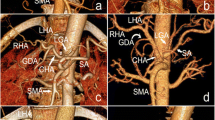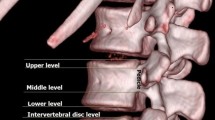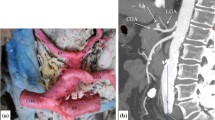Abstract
Purpose
To clarify the positional relationships among the celiac trunk (CT), the superior mesenteric artery (SMA), and the renal artery (RA) observed from the intravascular space to facilitate angiography.
Methods
After excluding six cadavers in which anatomic variation was found in the CT or SMA and four cadavers in which a curvature of 5° or more was observed in the aorta from 30 Japanese donor cadavers, we used the abdominal aortas of the remaining 20 cadavers as specimens. We made an incision in the maximum longitudinal diameter of the left RA (Lt. RA) and acquired an image of the intravascular space using a digital camera. The distance between the inferior borders of each vessel was used as the hypotenuse of a right-angled triangle. Lines parallel to the longitudinal diameter of the aorta and those parallel to the transverse diameter of the right-angled triangle were measured by a computer and expressed as relative distance indexes using the transverse diameter of the aorta at the Lt. RA level as a reference point.
Results
The transverse diameter of the aorta was 20.1 ± 2.9 mm, and the relative distance indexes for longitudinal/transverse lines between each vessel were 1.61/0.35 between Lt. RA and CT, 0.84/0.48 between Lt. RA and SMA, and 0.78/0.13 between CT and SMA. The angle between the transverse axis of the abdominal aorta and the linear line connecting CT and SMA was 80.2° ± 9.4°. The branching point of CT in relation to SMA was located at the upper left in 80 % (n = 16), on the same line in 15 % (n = 3), and at the upper right in 5 % (n = 1) of the subjects.
Conclusions
The relative distance indexes determined in this study will facilitate navigation during catheter insertion, particularly for those with little angiography experience, and thus reduce patient risk.



Similar content being viewed by others
References
Adachi B (1928) Anatomie der Japaner I. Das Arteriensystem der Japaner. Band II. Verlag der Kaiserlich-Japanischen Universität zu Kyoto. Maruzen Publishing Co., Kyoto, pp 20–71
Arnot RS, Louw JH (1973) The anatomy of the posterior wall of the abdominal aorta. Its significance with regard to hypoplasia of the distal aorta. S Afr Med J 47:899–902
Cauldwell EW, Anson BJ (1943) The visceral branches of the abdominal aorta: topographical relationships. Am J Anat 73:27–57
Kosiński H (1994) Variability of places of origin of the human renal arteries. Folia Morphol (Warsz) 53:111–116
Michels NA (1955) Blood supply and anatomy of the upper abdominal organs with a descriptive atlas. JB Lippincot Co., Philadelphia, pp 3–137
Michniewicz-Nowak M, Kosiński H (1986) Skeletopy of the origin of major branches of the abdominal aorta and of bifurcation of the aorta. Folia Morphol (Warsz) 45:262–268
Ozan H, Alemdaroglu A, Sinav A, Gümüsalan Y (1997) Location of the ostia of the renal arteries in the aorta. Surg Radiol Anat 19:245–247
Pennington N, Soames RW (2005) The anterior visceral branches of the abdominal aorta and their relationship to the renal arteries. Surg Radiol Anat 27:395–403
Sonesson B, Länne T, Hansen F, Sandgren T (1994) Infrarenal aortic diameter in the healthy person. Eur J Vasc Surg 8:89–95
Tandler J (1904) Zur Entwicklungsgeschichte der menschlichen Darmarterien. Anat Hefte 23(189–209):475–499
Yahel J, Arensburg B (1998) The topographic relationships of the unpaired visceral branches of the aorta. Clin Anat 11:304–309
Yan H, Kaneko M, Kato T, Takahashi M, Takai M, Nishimura T (1994) Relationship of the celiac and superior mesenteric arteries to the vertebral bodies and its clinical relevance. Radiat Med 12:105–109
Acknowledgments
The authors thank Drs. Ning Qu, Hayato Terayama, Shuichi Hirai, Takayoshi Miyaki, and Ms. Yuki Ogawa for their kind help in preparing this manuscript. The authors are indebted to Dr. Atsuko Kimura (PhD) and Associate Professor Edward F. Barroga (PhD) of the Department of International Medical Communications of Tokyo Medical University for their editorial review of this manuscript.
Conflict of interest
The authors declare that they have no conflict of interest associated with this study.
Author information
Authors and Affiliations
Corresponding author
Rights and permissions
About this article
Cite this article
Takahashi, T., Takeuchi, K., Ito, T. et al. Positional relationships among the celiac trunk, superior mesenteric artery, and renal artery observed from the intravascular space. Surg Radiol Anat 35, 411–417 (2013). https://doi.org/10.1007/s00276-012-1054-4
Received:
Accepted:
Published:
Issue Date:
DOI: https://doi.org/10.1007/s00276-012-1054-4




